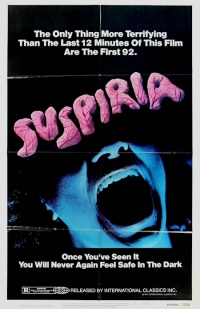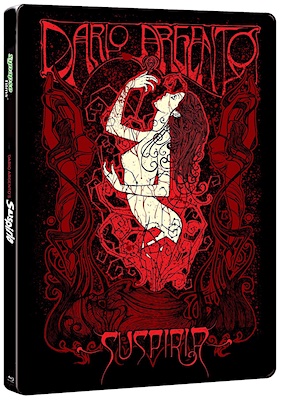Vincent Pereira is a life-long lover of film who worked for many years with Kevin Smith’s View Askew Productions, starting with Smith’s iconic indie classic Clerks. In 1997, Pereira wrote, directed and edited his own independent feature film, A Better Place, which played on the film festival circuit for several years before being released as a special-edition DVD by Synapse Films in 2001. A huge fan of Dario Argento, Synapse Films enlisted Pereira’s help in the remastering and restoration of Suspiria’s original 4-channel English-language sound mix for Synapse’s exclusive cinematographer-approved 4K restoration of the film, now available as a 3-disc limited-edition Blu-ray Steelbook release, and also available for pre-order in both double- and single-disc standard Blu-ray editions and a single-disc DVD.
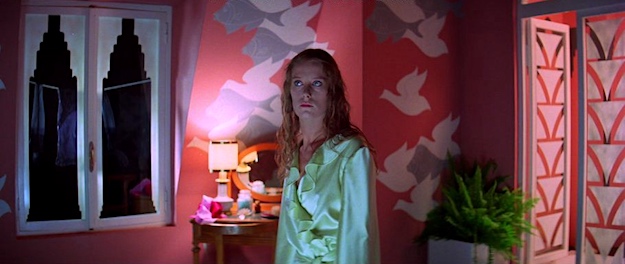
Michael Coate (The Digital Bits): How do you think Suspiria should be remembered on its 40th anniversary?
Vincent Pereira: As a true work of cinematic art. Horror movies are often overlooked or seen as being “less than” other genres, but Suspiria truly is a work of art. Visually and sonically, it’s a beautiful piece of cinema, aside from being a great horror film.
Coate: Can you recall the first time you saw Suspiria and what is your opinion of the film?
Pereira: I had read a lot about Suspiria long before I ever got to see it. I was a young horror movie fan in the 1980s, and I had this idea in my head of “the perfect horror movie” but I’d never seen it. The closest horror film to the “Holy Grail” in my head that I’d seen was John Carpenter’s Halloween (which I later found out was heavily influenced by Argento). Then, Fangoria magazine did a two-part interview with Dario Argento and his then-partner Daria Nicolodi in 1983, and the second part of the interview went into quite a bit of detail about Suspiria. Reading the description of Suspiria, it sounded like it truly was that “perfect horror movie” I had imagined in my mind. But way back then, Suspiria was not available on home video. The first time I saw any scenes from Suspiria was when I watched the Dario Argento’s World of Horror documentary, which included several clips from the film as well as behind-the-scenes footage, and that only made me more eager to see the full film! I was finally able to see Suspiria around 1987 via a VHS tape that was copied from the pan-and-scan Japanese LaserDisc. I later bought the letterboxed Image Entertainment LaserDisc in the early 1990s, the first time I was able to see Suspiria in its full widescreen glory.
The funny thing is, when I first watched Suspiria, I liked it — especially individual scenes and set pieces — but didn’t love it. I liked several of Argento’s other movies more. But I kept coming back to Suspiria. It’s an endlessly re-watchable film for me, and I came to “know” it very well. In 1991, I was able to actually see it projected in 35mm via the censored U.S. release, and the film came alive to me seeing it that way that it never came across like on home video. Projected on a big screen, even the “boring” scenes suddenly came alive thanks to the amazing sets, art direction, cinematography and use of color. The more I watch it, the more I appreciate it as a true work of art.
Coate: Is Suspiria a significant (horror) film in any way?
Pereira: It is, in many ways. The Goblin music score has become a classic and has inspired many other scores (i.e. Halloween). The extended horror set pieces are amazing and have become classics, in particular the justifiably famous opening double-murder sequence. The set design, art direction and cinematography are gorgeous. The 4-channel stereo surround mix gives many modern movie sound mixes a run for their money.
Coate: In what way was Dario Argento an ideal choice to direct Suspiria, and where does the film rank among his body of work?
Pereira: It’s his most famous film, and with good reason. There simply doesn’t exist another horror movie that looks or sounds like Suspiria. Dario had an idea for a look and sound to this film and ran with it, and the results speak for themselves. He was at the right time in his career to be able to take the chances he did with Suspiria and collaborating with his partner and co-writer Daria Nicolodi, and they created something special and timeless.
Coate: Is it necessary to recognize Suspiria as a part of a trilogy in order to enjoy it?
Pereira: Suspiria works as a stand-alone film. Argento didn’t really establish the “mythology” until the second film, Inferno (1980). They are both great works of art in the horror genre in my opinion. Mother of Tears — the final film in the trilogy that finally surfaced in 2007 — connects directly with both Suspiria and Inferno, but doesn’t live up to either of them artistically. It’s trashy fun in its own way, but not at all on par with either Suspiria or Inferno.
Coate: How would you describe Suspiria to someone who has never seen it?
Pereira: Suspiria is a multicolored fairy-tale that’s collided head-on (and at full-speed) with a fever-dream lucid nightmare.
Coate: Can you discuss the film’s audio? How does the new audio mix compare to the original mix?
Pereira: There is no “new audio mix” on the Synapse Blu-ray, but rather a meticulous remastering and restoration of the original 4-channel discrete English-language mix, which has never been heard outside of select premiere original 35mm prints from 1977. For this release, Synapse was determined to include the original 4.0 theatrical sound mix. The owners of the film in Italy did not have the elements, but [Synapse Films President] Don May is a great detective as well as an incredible lover of film, and after considerable effort he was able to track down almost-pristine 35mm magnetic elements for the uncut version of Suspiria in Los Angeles. These were 35mm magnetic “stems” (separate dialogue, music, and effects tracks) for the 4-channel original English mix. Don, his amazing audio engineer here in Michigan, Spencer Hall, and myself worked with these stems to remaster and restore the original 4-channel discrete L-C-R-S (Left-Center-Right-Surround) mix for the Synapse Blu-ray. We did not remix the film; rather, our goal was to restore and remaster the original discrete 4-channel mix. Synapse wanted to present the barely-heard original 4-channel discrete magnetic mix from 1977 in the highest quality possible, and I think they have succeeded in spades. All the original 35mm magnetic elements were transferred at 96kHz/24-bit resolution, and the remastering and audio restoration was done at the same 96/24 high-resolution and has been presented on the Blu-ray in 96/24 as well, in the original 4.0 configuration.
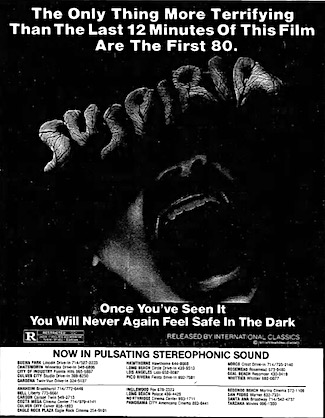
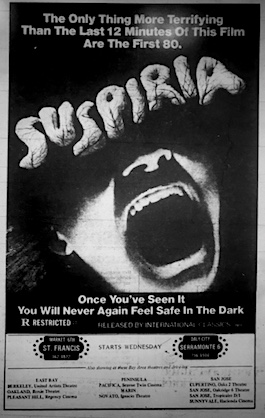
Coate: What audio was featured on the previous home video releases of this film?
Pereira: The earliest home video versions of Suspiria had 2-channel stereo mixdowns of the 4-channel discrete L-C-R-S original 35mm English-language sound mix. Suspiria was mixed and originally released in premiere theaters in 4-channel discrete magnetic sound. There was no home video format to support 4-channel discrete in the 80s/90s, so a 2-channel stereo mixdown was made from the 4-track original. There was an early CX-analog stereo Japanese LaserDisc from the mid-1980s, and the much more widely-known Image Entertainment LaserDisc from the early 1990s. Both of these contained 2-channel stereo mixdowns of the 4-channel original.
In 2001, Anchor Bay in collaboration with Blue Underground released a DVD version of Suspiria which included a top-to-bottom 6.1 remix from original audio stems. Unfortunately, said remix had a lot problems. Music cues, dialogue, and effects were missing, and many sound effects and music cues were at improper sound levels, to boot, and to make matters worse, the original mix was not included as a viewing option.
Several Blu-ray versions of Suspiria have been issued over the years, both based on a 2007 HD master, and a 2016 4K remaster commissioned by the rights holder, Videa, in Italy. The sound on all of those Blu-rays has either been a variation on the flawed Anchor Bay/Blue Underground remix, or based on the Image Entertainment 2-channel mixdown of the 4-track original, either presented as 2-channel, or reprocessed to a “faux” 5.1 track.
Unlike all of these other versions, the Synapse Films release presents the actual, original 4.0 channel configuration, remastered and restored in 96/24 resolution from original 4-channel L-C-R-S 35mm DME (Dialogue/Music/Effects) stems. This is the first time the actual 4-channel original mix has been presented on home video, and literally the first time it’s been heard outside of select cinemas that were lucky enough to get 4-track mag prints back in 1977. There is simply no other version of Suspiria that can compare in terms of audio to what Synapse Films has restored here.
Coate: How does the new Synapse Blu-ray release differ from prior releases?
Pereira: See [my answers to your two previous questions] regarding the audio. Regarding the image: Don May reached out to Suspiria’s cinematographer Luciano Tovoli. Tovoli was ecstatic to be asked to be involved (he was shut out of a concurrent European restoration), and he and Don and Don’s colorist David Block went back-and-forth for several months making adjustments and changes, until Tovoli was finally completely happy and signed off on the Synapse 4K restoration. Tovoli even insisted on the Synapse 4K restoration being screened in Spain where he was speaking. The Synapse version of Suspiria is the only one that Luciano Tovoli, the original cinematographer who designed the unique look of the film, has personally supervised and approves.
Coate: I understand a remake is currently in production. Any thoughts?
Pereira: Unlike a lot of people, I’m not immediately against remakes, even of films I love. If the remake is good or bad, the original film still exists. In the case of Suspiria, the remake is being made by the well-respected and now Academy-award nominated director (for Call Me By Your Name), Luca Guadagnino. He has said in interviews that as a young teenager, the original Suspiria profoundly affected him, and that his film is not a remake per se, but rather inspired by the original film and his love of it. I’m actually very much looking forward to seeing what he has to say with his new film interpretation, and what he has done with his inspiration from Argento’s original masterpiece.
Coate: What is the legacy of Suspiria?
Pereira: Suspiria is not just a “horror film”; it’s a work or cinematic art that has influenced countless other filmmakers. It transcends genre. It works beautifully not just as a “mere horror film,” but also works as a profound work of visual and aural art.
Coate: Thank you, Vincent, for sharing your thoughts about Suspiria on the occasion of its 40th anniversary.
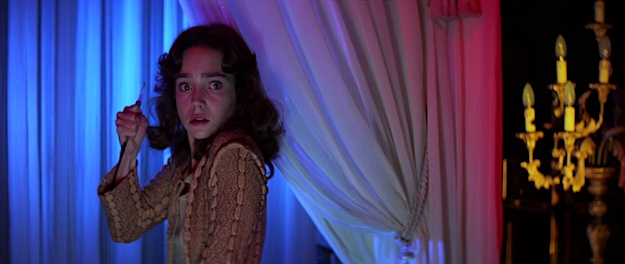
IMAGES
Selected images copyright/courtesy Anchor Bay Entertainment, International Classics, Seda Spettacoli, Synapse Films, 20th Century Fox Film Corporation.
- Michael Coate
Michael Coate can be reached via e-mail through this link. (You can also follow Michael on social media at these links: Twitter and Facebook)


